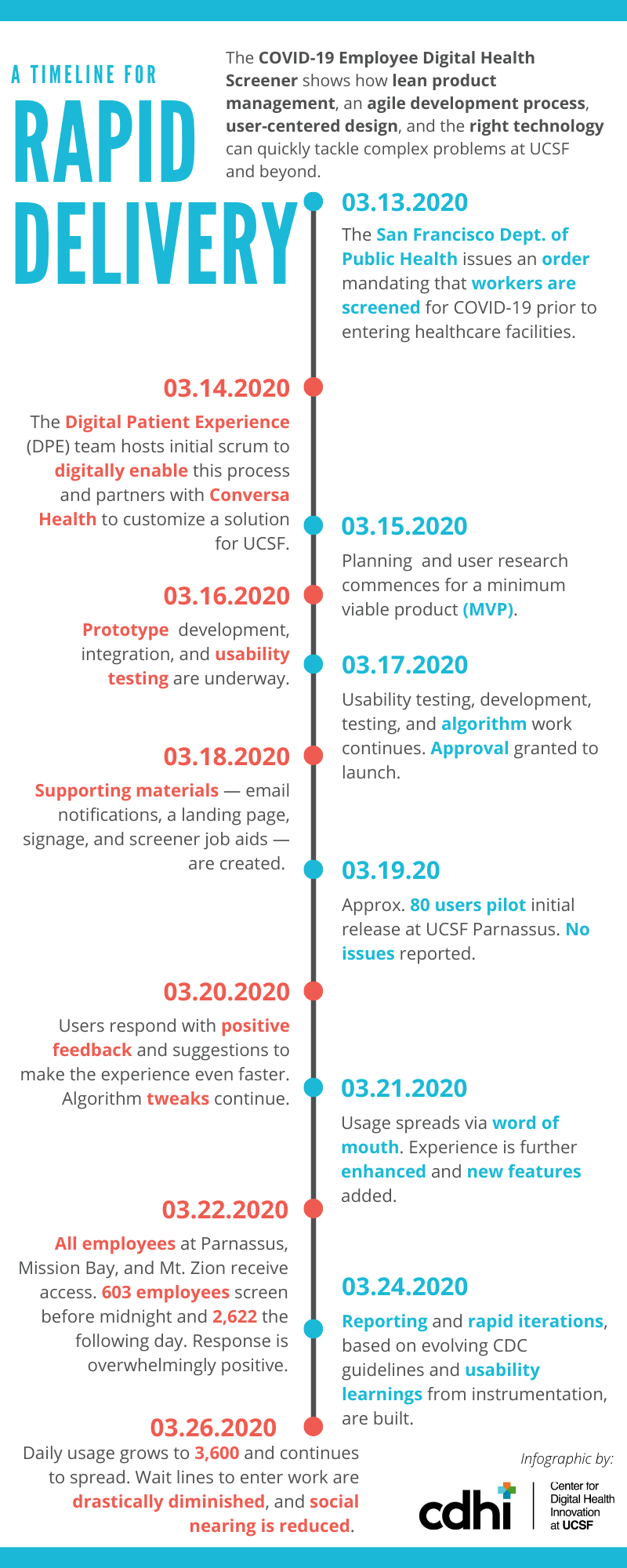Case Study: COVID-19 Employee Digital Health Screener
• A total time savings of over 1,000 hours was projected during the first four weeks of use compared to in-person screening
• Average employee wait time to enter work reduced by 80%
• Launched within 5 days
Ensuring the Health & Safety of Patients, Employees, & Providers at UCSF During COVID-19
On March 13, 2020, the City and County of San Francisco issued an order mandating the daily screening of healthcare workers for COVID-19 symptoms prior to entering the workplace.
Manually screening thousands of employees per day across three shifts was time intensive and required employees to stand in long lines, possibly exposing themselves and others to COVID-19 or other illnesses. During the longest peak time, an employee waited in line for nearly half an hour before entering work.
What Did We Do?
To expedite the process of screening employees each day, the Center of Digital Health Innovation at UCSF partnered with Conversa Health to customize an online, chat-based screening that employees could use before heading to work.
CDHI had a pre-existing partnership with Conversa to use its Virtual Care and Communication Platform to help patients in myriad use cases across the health system and knew this technology could be quickly adapted for employee screening for COVID-19. By employing user-centered design and an agile product development process, CDHI launched an employee health screener to UCSF employees within five days of the city order that fit seamlessly into the existing workflow.
How it Worked
1. The screening tool presented employees with a series of questions based on CDC guidelines and UCSF Occupational Health Return-to-Work guidelines.
2. Employees with no identified risk were cleared to enter UCSF using a designated line, and showing a date-stamped pass, similar to TSA Pre-Check.
3. Employees with symptoms or other risk factors (e.g., recent travel to a hot spot area) received instructions for further assessment and/or treatment.
4. During the first month, more than 100,000 screenings were completed with this tool, and usage continued to expand to the entire UCSF campus and other affiliations.
Chatbot screenshots: (A) exposure questions, (B) attestation and clearance, (C) clearance pass, (D) clearance pass requiring letter from Occupational Health Services (OHS), and (E) expired pass. (J Am Med Inform Assoc. 2020 Jul 1;27(9):1450-1455. doi: 10.1093/jamia/ocaa130. PMID: 32531066; PMCID: PMC7313990.).
image is from here: https://www.ncbi.nlm.nih.gov/pmc/articles/PMC7313990/
What Was Our Impact?
• Used more than 1 Million times (~10k uses/day )
• Nearly 99% of screenings resulted in full clearance; less than 1% resulted in instructions to stay home
• Reduced risk of exposure due to “social nearing” in lines and screener/employee interaction by automating screening at home
• A total time savings of over 1,000 hours was projected during the first four weeks of use compared to in-person screening
• Average employee wait time to enter work reduced by 80%
• Launched within 5 days
What We Learned and What Happened Next
After its launch, the product team worked over the next several months to improve its functionality, including the addition of an expedited chat function, which allowed employees who had screened negative in recent days to bypass most questions.
In October 2022, UCSF assessed employee needs and decided to switch gears. To better suit long-term use, the employee health screener was rebuilt using different software, following the same agile approach used for our products.
Prior to the software rebuild, the screener was used more than a million times. Since then, it has been licensed as a commercial tool for several large employers across the United States, generating the first-ever royalty revenue for UCSF Health.
To learn more about the Employee Health Screener

